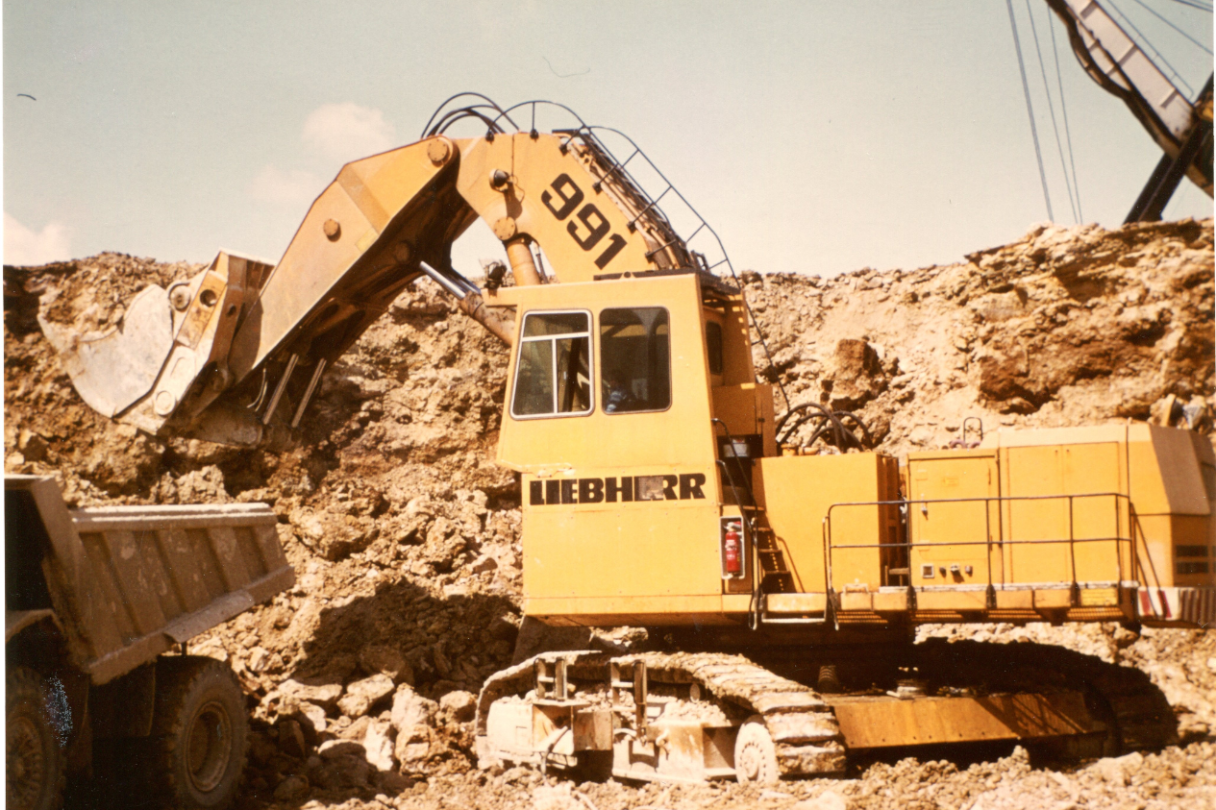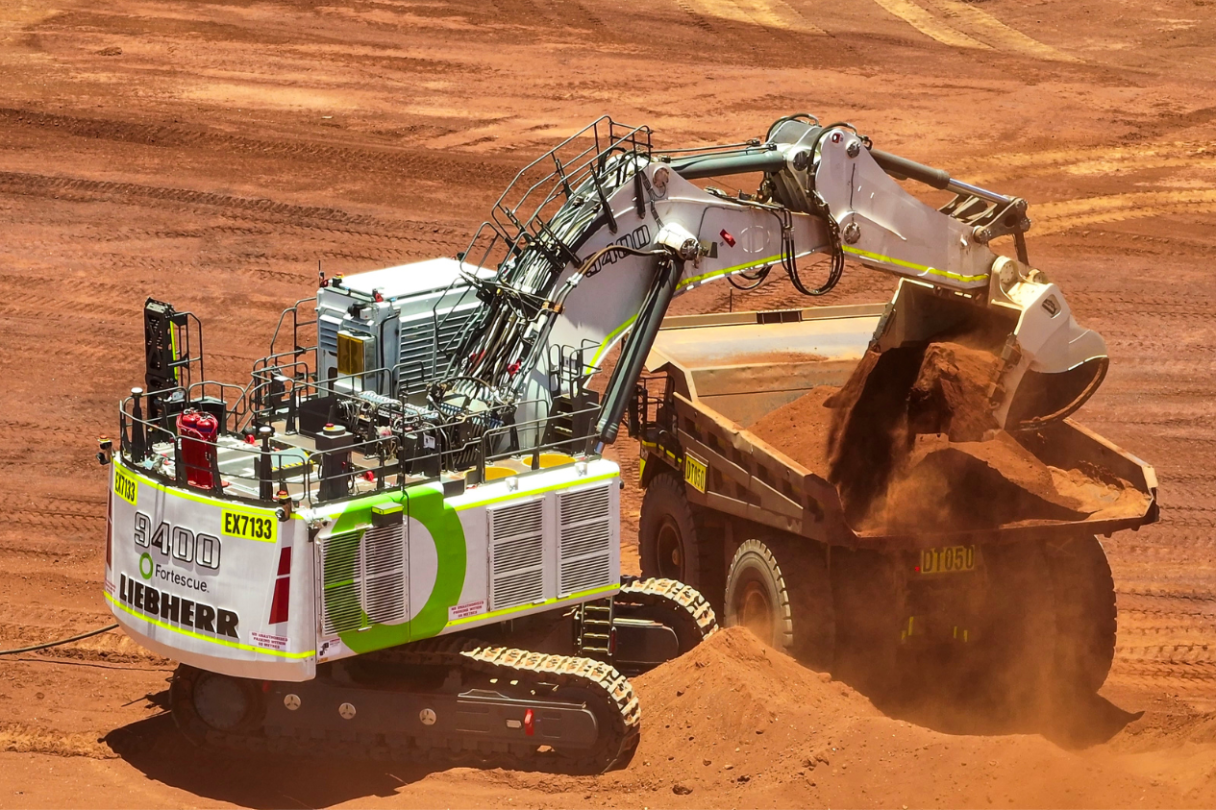All about our electric excavators
Liebherr Mining has more than 40 years of experience in developing, manufacturing and supporting electric excavators and we are exceptionally proud of these machines. Here are some things you might not have known about these electrifying loading solutions.
The very first Liebherr electric excavator was delivered in September 1981.
This historic excavator was an R 991 E – a 150-tonne machine – and was delivered to one of the largest cement producers in Germany. The R 991 E was built by Liebherr-France SAS, as our mining excavator factory in Colmar wouldn’t be founded for another 29 years.
Fun fact: this customer still works with us today!

There is strong parts commonality between our electric-drive excavators and those with internal combustion engines.
Approximately 70 % of a Liebherr electric excavator is the same as a Liebherr excavator with an internal combustion engine (ICE). To build a Liebherr electric excavator, we take out engine-related components (such as the cooling system, fuel system and exhaust), replace the rotary connection, and install the electric motor and the high and low voltage electrical cabinets. The rest stays the same. And it’s this strong parts commonality between our ICE and electric-drive excavators that allows us to offer repowering options for all of our latest excavators.
Our electric excavators work in different countries – and commodities – all over the world.
You will find our electric excavators in 19 different countries across 4 continents. These machines work in all sorts of applications: dredging, copper, coal, iron ore, construction, demolition, limestone, basalt, zinc, gold and even diamond.
We are also adapting our electric excavators to meet a wider range of local electrical standards – such as UL, CSA and AS/NZS – and to have more voltage, frequency and cable options to meet customers’ site requirements. This means more customers can have the opportunity to experience the power of our electric excavators on site.
Using electric excavators on site has a range of benefits for customers.
Including our electric excavators in mining operations offers more advantages than you might think. Opting for an electric machine can dramatically reduce greenhouse gas (GHG) emissions. For example, making the switch from an R 9400 to an R 9400 E can decrease onsite GHG emissions by up to 3,230 tonnes per year. Running an electric excavator on site also significantly reduces the machine’s cost per tonne, as the machine operates without burning fuel. Additionally, using electric excavators instead of ICE excavators reduces the amount of waste on site. With an ICE excavator, the engine oil, oil filters, fuel filters, coolant filters and air filters all need to be changed every 250–500 hours. However, because an electric excavator does not use an ICE, it does not need to consume – and therefore customers do not need to environmentally manage – all of these items!
Customers using our electric excavators also report better efficiency, longer component life, fewer vibrations during operation and less noise pollution.

Building electric excavators is a team effort.
To make sure customers always get the very best from us, we routinely work with colleagues from Liebherr’s components, earthmoving and mobile and crawler cranes product segments – all of which have extensive experience with high voltage components and electric machinery. Collaborating with our colleagues in these business areas allows us to share information about different technologies, as well as safety and standard compliance.
For our latest excavators, the machines with internal combustion engines and those with electric motors are developed in parallel.
Since the advent of our Generation 8 machines, we’ve ensured that the ICE and electric-drive versions of each model begin production at very similar times. This means customers can choose which of these options would work best for their mine sites. And, if customers wish to convert their ICE excavators to an electric motor, our modular design approach to our machines means that this can happen easily. We incorporate future-proofing into our machine designs so our equipment can support our customers for as long as possible.
Our electric excavators plus our cable reel solution? A perfect match.
When using an electric excavator, cable management is paramount. With our cable reel solution, customers can enjoy up to 300 metres of autonomous cable reeling. This not only resolves mobility constraints, but also optimises productivity and the safety of onsite personnel. All without reducing the ground clearance of the excavator.
We can customise our electric excavators to best suit your operation.
At our excavator factory in Colmar, France, we have a design team within the engineering office that can create tailor-made electric excavator solutions. This team works alongside our application engineers, who travel to customers’ mines and study their day-to-day operations. The engineers then collect the data gathered during their site assessments and use this to propose the best options based on customers’ digging practices, cable management and network layout. All of this information is then passed to our design team so they can put together an electric excavator package that will provide customers with the best possible performance on site.
